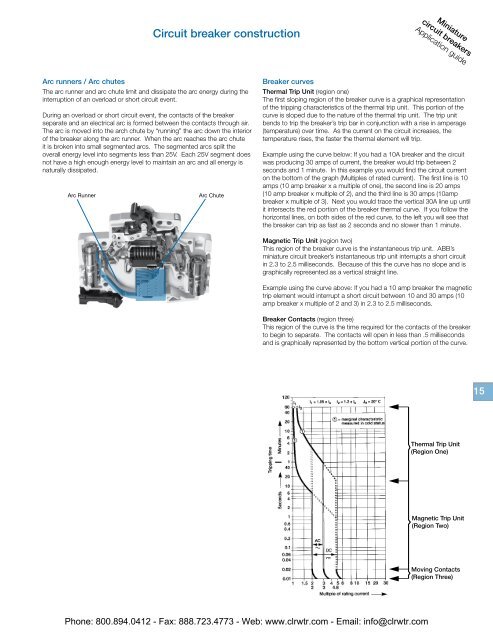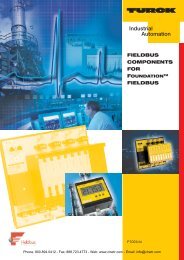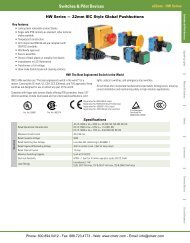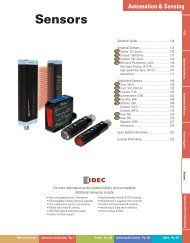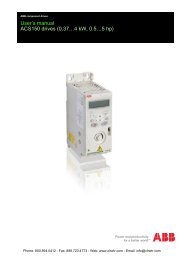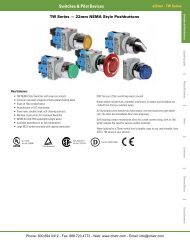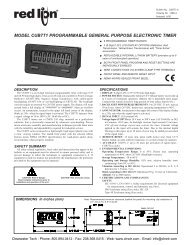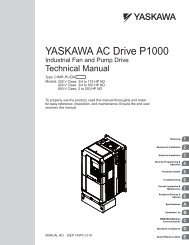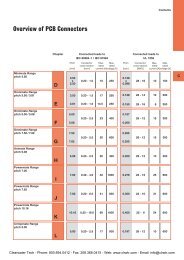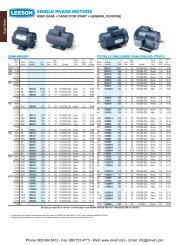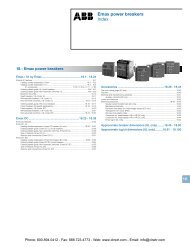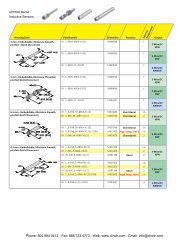ABB Miniature Circuit Breakers Catalog
ABB Miniature Circuit Breakers Catalog
ABB Miniature Circuit Breakers Catalog
Create successful ePaper yourself
Turn your PDF publications into a flip-book with our unique Google optimized e-Paper software.
circuit circuit breakers breakers<br />
<strong>Circuit</strong> breaker construction<br />
<strong>Miniature</strong> <strong>Miniature</strong><br />
S200<br />
Application guide<br />
Arc runners / Arc chutes<br />
The arc runner and arc chute limit and dissipate the arc energy during the<br />
interruption of an overload or short circuit event.<br />
During an overload or short circuit event, the contacts of the breaker<br />
separate and an electrical arc is formed between the contacts through air.<br />
The arc is moved into the arch chute by “running” the arc down the interior<br />
of the breaker along the arc runner. When the arc reaches the arc chute<br />
it is broken into small segmented arcs. The segmented arcs split the<br />
overall energy level into segments less than 25V. Each 25V segment does<br />
not have a high enough energy level to maintain an arc and all energy is<br />
naturally dissipated.<br />
Arc Runner<br />
Arc Chute<br />
Breaker curves<br />
Thermal Trip Unit (region one)<br />
The first sloping region of the breaker curve is a graphical representation<br />
of the tripping characteristics of the thermal trip unit. This portion of the<br />
curve is sloped due to the nature of the thermal trip unit. The trip unit<br />
bends to trip the breaker’s trip bar in conjunction with a rise in amperage<br />
(temperature) over time. As the current on the circuit increases, the<br />
temperature rises, the faster the thermal element will trip.<br />
Example using the curve below: If you had a 10A breaker and the circuit<br />
was producing 30 amps of current, the breaker would trip between 2<br />
seconds and 1 minute. In this example you would find the circuit current<br />
on the bottom of the graph (Multiples of rated current). The first line is 10<br />
amps (10 amp breaker x a multiple of one), the second line is 20 amps<br />
(10 amp breaker x multiple of 2), and the third line is 30 amps (10amp<br />
breaker x multiple of 3). Next you would trace the vertical 30A line up until<br />
it intersects the red portion of the breaker thermal curve. If you follow the<br />
horizontal lines, on both sides of the red curve, to the left you will see that<br />
the breaker can trip as fast as 2 seconds and no slower than 1 minute.<br />
Magnetic Trip Unit (region two)<br />
This region of the breaker curve is the instantaneous trip unit. <strong>ABB</strong>’s<br />
miniature circuit breaker’s instantaneous trip unit interrupts a short circuit<br />
in 2.3 to 2.5 milliseconds. Because of this the curve has no slope and is<br />
graphically represented as a vertical straight line.<br />
Example using the curve above: If you had a 10 amp breaker the magnetic<br />
trip element would interrupt a short circuit between 10 and 30 amps (10<br />
amp breaker x multiple of 2 and 3) in 2.3 to 2.5 milliseconds.<br />
Breaker Contacts (region three)<br />
This region of the curve is the time required for the contacts of the breaker<br />
to begin to separate. The contacts will open in less than .5 milliseconds<br />
and is graphically represented by the bottom vertical portion of the curve.<br />
15<br />
Thermal Trip Unit<br />
(Region One)<br />
Magnetic Trip Unit<br />
(Region Two)<br />
Moving Contacts<br />
(Region Three)<br />
Phone: 800.894.0412 - Fax: 888.723.4773 - Web: www.clrwtr.com - Email: info@clrwtr.com


